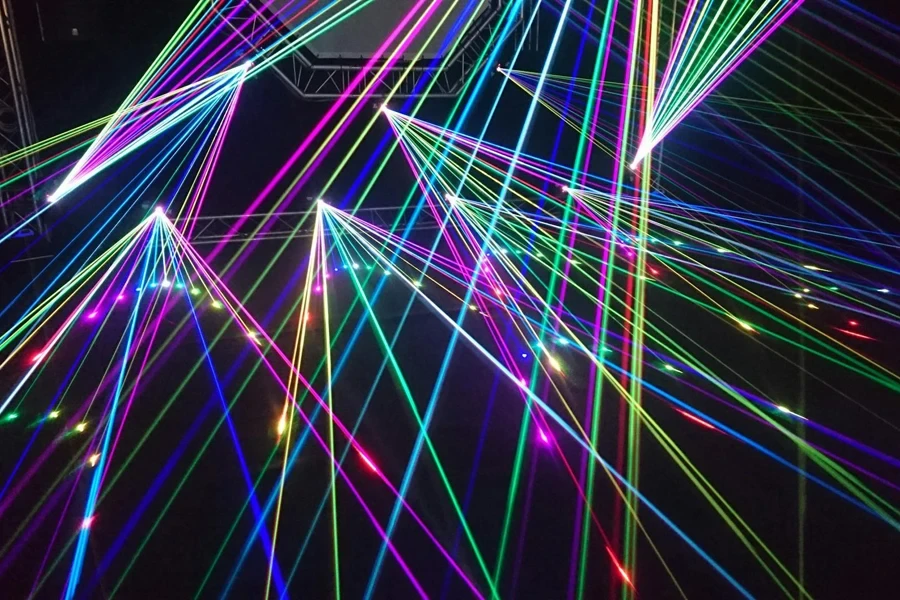Table of Contents
● Introduction
● Market overview
● Comparison of red vs. green laser pointers
● Things to consider when selecting laser pointers
● Conclusion
Introduction
Laser pointers, once a simple tool for presentations, have evolved into essential devices across educational, business, and entertainment sectors, as well as in military applications. This diversity in use underscores the necessity for understanding the current market trends, which reveal a growing preference for specific types based on application needs. Green lasers are gaining popularity for their visibility and range, especially in well-lit environments, while red lasers continue to be valued for their cost efficiency and battery life. As the market expands, both the technology behind laser pointers and the regulations governing their use are also advancing. For businesses selecting laser pointers, a comprehensive knowledge of these market dynamics and product specifics is critical to making informed purchasing decisions.
Market overview

Market share and leading regions
The laser pointer market is anticipated to experience notable growth, forecasted to reach substantial revenues by 2028, with a steady compound annual growth rate (CAGR) of 1.2% through the forecast period. North America is currently at the forefront, holding a significant share of the market due to robust demand in both the military and entertainment sectors. This demand is fueled by the region’s quick adoption of advanced technologies that offer greater visibility and range, making these tools indispensable in various applications.
Market trends and changes
Market trends further reveal an increasing integration of laser pointers across multiple sectors, including educational environments, where they are employed extensively for presentations and in entertainment, used to enhance visual effects at live performances. The technology’s adaptability in terms of color and wavelength customization—such as green lasers that are preferred for their visibility in daylight conditions and red lasers chosen for their energy efficiency—caters to specific user requirements. Despite this growth, the market faces challenges from stringent safety regulations, which meticulously control the production and distribution of laser pointers. These regulations, aimed at preventing injuries, particularly from high-powered lasers, influence market dynamics by imposing limits on the availability and use of certain types of laser pointers.
Comparison of red vs. green laser pointers

The choice between red and green laser pointers largely hinges on their differences in brightness, visibility, range, battery life, and cost, each of which serves distinct needs depending on the usage scenario.
Brightness and visibility
Green lasers are significantly brighter and more visible than their red counterparts, particularly in well-lit environments or daylight. This increased visibility is due to the human eye’s higher sensitivity to green light, around 532 nanometers in wavelength, as opposed to red light, which typically ranges from 635 to 650 nanometers. The enhanced brightness of green lasers makes them more effective for applications requiring visibility from greater distances, such as in outdoor educational settings or stargazing.
Range and distance
The effectiveness of laser pointers also varies with their range and distance capabilities, which are influenced by the light’s wavelength. Green lasers, with their shorter wavelength, scatter less in the atmosphere compared to the longer wavelengths of red lasers. This attribute allows green lasers to maintain a more focused beam over longer distances, making them ideal for uses in larger lecture halls or for pointing out distant objects in both academic and recreational outdoor activities.
Battery life and energy efficiency
Despite their advantages in visibility and range, green lasers typically require more power, which can lead to shorter battery life. Red lasers, conversely, are more energy-efficient due to their longer wavelengths requiring less power to produce a visible beam. This makes red lasers a more suitable option for situations where long battery life is crucial, such as during prolonged academic sessions or conferences where changing batteries frequently would be impractical.
Cost factors
Cost is a significant factor when choosing between red and green laser pointers. Green lasers generally come with a higher price tag, attributed to the more complex technology required to generate green light. This technology involves an additional process where infrared light is converted into visible green light, adding to the production costs. As a result, red lasers remain a cost-effective solution for many educational and business environments where extensive visibility and range are less critical.
Things to consider when selecting laser pointers
Laser safety and classification

Laser pointers are classified by regulatory bodies such as the FDA based on their potential to cause eye injury. Class II lasers emit visible light with a power output of up to 1 milliwatt (mW) and are considered safe for general use, posing minimal risk if exposure is brief. Class IIIa lasers have a power output between 1 and 5 mW and require more caution, as direct exposure can cause eye damage. Higher classes, such as Class IIIb (5 to 500 mW) and Class IV (above 500 mW), are hazardous and typically restricted for industrial, scientific, or military use. Understanding these classifications helps users select a laser pointer that balances performance with safety.
Application-specific suitability
Different applications demand specific types of laser pointers. In educational and business settings, where the primary need is to highlight text or objects on a screen or board, a red laser pointer (635-650 nm) with lower power is sufficient. For outdoor activities or scenarios requiring long-distance visibility, such as construction sites or stargazing, a green laser pointer (532 nm) is ideal due to its superior brightness and visibility. Industrial applications might require laser pointers with higher precision and power, necessitating careful consideration of both wavelength and output power to meet specific needs.
Wavelength considerations
The wavelength of a laser pointer affects its visibility and effectiveness for different tasks. Green lasers, emitting at 532 nm, are more visible to the human eye due to the peak sensitivity of the eye’s photoreceptors to green light. This makes them suitable for applications needing high visibility in various lighting conditions. Red lasers, with wavelengths around 635-650 nm, are less bright but can be more effective for tasks that do not require high visibility, such as short-range pointing or use in controlled lighting environments. Blue and violet lasers, emitting at 405-450 nm, offer unique applications in scientific research but are less common for general use due to their potential to cause more eye strain.
Cost-performance balance
While green lasers are generally more expensive due to the intricate technology required to produce them, their high visibility and performance can justify the cost for specific applications. Red lasers are more cost-effective, offering adequate performance for indoor or short-range applications. When selecting a laser pointer, it is essential to consider not only the initial cost but also the long-term benefits and operational efficiency. Higher-priced lasers might offer better durability, energy efficiency, and versatility, leading to cost savings over time, especially in professional or frequent-use scenarios.
Conclusion

Selecting the right laser pointer is crucial for meeting specific operational needs, whether for educational, business, or industrial applications. Businesses must consider factors such as brightness, range, safety classifications, wavelength, and cost to ensure optimal performance and safety. By thoroughly evaluating these technical aspects, companies can make informed decisions that enhance their product offerings, leading to increased customer satisfaction and better market positioning. Understanding these differences not only helps in selecting the most appropriate laser pointer but also supports effective reselling strategies, ensuring clients receive products that meet their exact requirements and deliver exceptional value.



